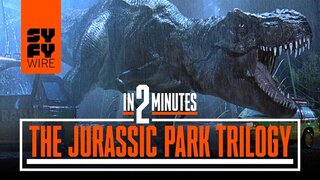Create a free profile to get unlimited access to exclusive videos, sweepstakes, and more!
'Life Finds a Way': Crocodile Has Jurassic Park-Style Virgin Birth by Impregnating Itself
A crocodile that's been isolated from other crocs for 16 years has had a "virgin birth." Sound familiar, Jurassic Park fans?
As Dr. Ian Malcolm explained in the original Jurassic Park film (now streaming on Peacock), "Life finds a way." The sarcastic scientist, flawlessly played by Jeff Goldblum, was referring to the dinosaurs in the fictional theme park that were intentionally engineered to all be female in hopes of preventing breeding. But just as the dinos in the blockbuster sci-fi film found a way to breed new life despite being denied the usual means to do so — so has a crafty Costa Rican crocodile who had a "virgin birth."
The croc, 18 at the time, had been housed in a zoo since it was two years old "and maintained in isolation from other crocodilians for its entire life" when 14 eggs were found in its enclosure in 2018, according to a new study. "After three months of incubation, the eggs had failed to hatch and were opened to assess their contents," reads the study published Wednesday in the scientific journal, Biology Letters.
RELATED: 30 Years Later, Jurassic Park Remains Visually Awe-Inspiring
"One egg was found to contain a fully formed non-viable fetus that upon dissection was determined via gross gonadal morphology as female," the study continued. "DNA was extracted from a scute shed by the mother and cardiac muscle obtained from the fetus" and sent to a biotechnology company in California for whole-genome sequencing, where it was determined that the fetus only had genetic material from its mother, and no dad.
This type of reproduction without fertilization, called parthenogenesis, has been seen before in plants and creatures like ants, wasps, bees, birds and snakes — but this is the first time the so-called "virgin birth" has been seen in a crocodile.
The phenomenon occurs, as the New York Times explains, when an egg cell in its mom's body divides repeatedly to form a being with half the genes needed for a new creature. In most cases, polar bodies, created as byproducts, usually die out. But in parthenogenesis, a polar body fuses with the egg, making a cell with the all the chromosomes needed to make a new being.
Warren Booth, a Virginia Tech professor who did research on the croc eggs, told the Times that since crocodiles evolved way before many other parthenogenetic animals, this suggests that "it’s very likely that this also happened in pterosaurs and dinosaurs."
So, Ian Malcolm has been proven right again. In Jurassic Park, the scientist/mathematician who specializes in chaos theory was skeptical when scientists at the theme park told him that the park is under control because all the dinosaurs are bred to be female. "If there's one thing the history of evolution has taught us," Ian says, "it's that life will not be contained. Life breaks free. It expands new territories and crashes through barriers, painfully, maybe even dangerously."
When a park-employed scientist asks if he's implying that "a group composed entirely of female animals will breed," Ian responds, "I'm simply saying that life finds a way." Of course, later on in the Universal Pictures' film, broken dinosaur egg shells are found in the park and it's clear that the reptiles have been breeding on their own, despite being engineered to all be female. In the film, it's determined that some of the creatures have been able to change their sex due to living in a single-sex environment, like some frogs can do.
To catch the above Jurassic Park scenes and others, check out the original film — along with The Lost World: Jurassic Park, Jurassic Park III, and Jurassic World — all streaming now at Peacock.






























